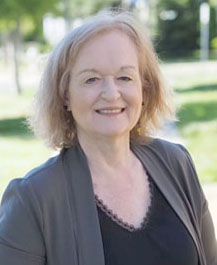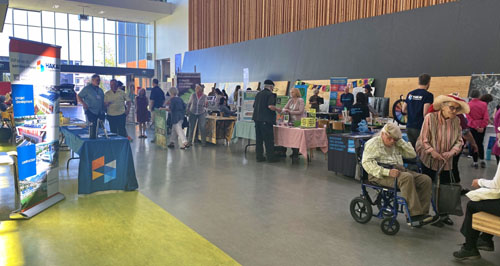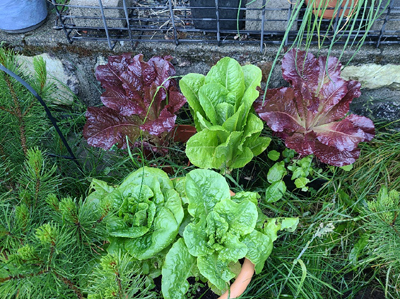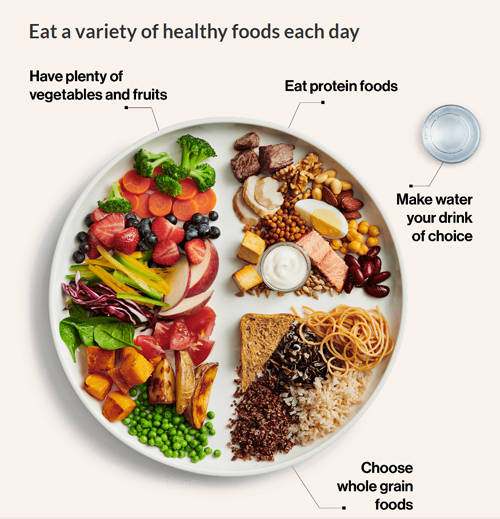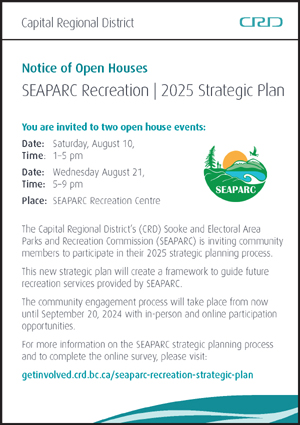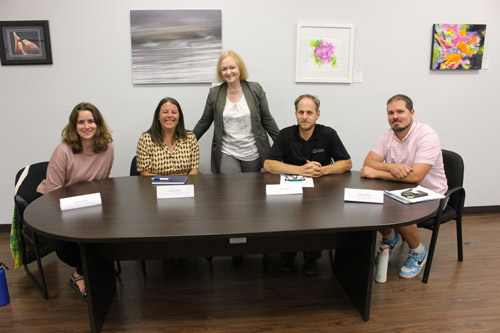
Sunday July 28, 2024 | VIEW ROYAL, BC [Updated July 30, 2024]
by Mary P Brooke, Editor, Island Social Trends
Exploring ways to mobilize more municipal action around food-growing and storage in urban communities was the focus of a four-speaker panel in View Royal last week.
The highly-informative July 24 two-hour panel event was organized by the Urban Food Resilience Initiatives Society (UFRIS), hosted by by UFRIS Lead Mary P Brooke.

Speakers addressed a range of topics that feed into the success of urban food growing by households and other built-structure environments like office buildings, warehouses, and schools.
“We’re supporting a lot of things here today — nutrition and growing of food for economic reasons, and working with the municipalities to make sure that everyone has the opportunity to do this,” said Brooke.
They shared tips for successful food growing, how municipalities can be supportive in this venture, food storage for emergencies, soil development, and water supply usage and conservation.
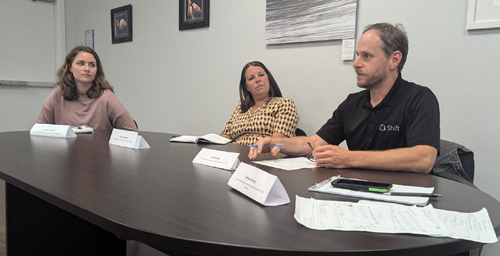
Attending in the audience were Langford Councillor Mary Wagner (who sits on the city’s Sustainable Development Advisory Committee and is spreadheading the first Langford community garden) and Colwood Councillor David Grove (who supports the Colwood Community Garden expansion initiative and used to supply his own bakery with food grown on-site).

The event was held in View Royal at the community constituency office of Mitzi Dean, MLA.
Growing food at home and in community:
“There have been significant changes in the economy in the last couple of years. People’s eroded ability to buy enough good quality food has motivated the UFRIS group to address how municipalities can support the well-being of their residents,” said UFRIS Executive Lead Mary Brooke at the outset of her remarks on July 24.
“Having people grow food in their own yards is the direction we want to go, and we want to have municipalities be supportive of that whether through infrastructure, community gardens, community education pieces — there are a lot of ways to keep this moving.” she said in her introduction ahead of the four-speaker panel presentation.
“There is some data that people are spending less at the grocery store — they’re buying less — but the cost of everything is up. So you would think the mathematical calculation would mean that they’re not buying as much food that is healthy. The most expensive food is produce, meat and dairy,” said Brooke, who has a B.Sc. in nutrition and community education.
“As well, there could also be a shift to more people buying food from the local markets and natural food providers — and that’s cutting in to what we buy at the grocery store. And also more people are starting to grow more food in their own yards, when before they had not undertaken that activity at their homes; it’s a movement that’s starting,” she said.
MICHIAILA FRAWLEY – Soil Science Specialist and soil supplier.
- She works at Sooke Soil, a company started by her father about 13 years ago. The Sooke area has grown quite a bit since then, and Sooke Soil along with that. They provide gravel, soils and compost and mulches, landscaping and gardening supplies to homeowners, landscapers, farmers, and contractors. They accept yard waste and yard refuse.
- She sees more people buying soil for their food-growing gardens. Either built raised bed or have pots or planters at townhomes or condos, looking for soil that is ready-to-plant-in. From truckloads to small pots, soil can be supplied. Small quantities are important for urban growing.
- Soil quality can be enhanced with soil amendments such as finished compost (organic matter). Mulch helps reduce loss water from the soil.
- Municipalities can support in terms of soil: new developments use fill soil (screened for large items like rocks or sticks and then put back in) for the entire property and put sod on it. There’s no added organic matter for household yards in new developments, and soil structure is gone. Weed seeds and invasive species can be present in this sort of soil. Usually that soil is dry and doesn’t drain very well.
- Good healthy soil doesn’t require as much water and will drain well, reducing any property damage.
- Builders, contractors and homeowners can all benefit by good quality soil.
- Home composting can be a challenge, and if yard waste is kept on a household property it can be a fire risk. She recommends yard waste programs for municipalities, including for management of invasive species.
- [Michaila Frawley’s full presentation is in the Urban Food Panel Report – July 24, 2024 – available by donation from Urban Food Resilience Initiatives Society]
BRIANNA STEWART – Managing Director, FED Urban Agriculture Society and member of the Urban Food Table policy advisory board to the City of Victoria.
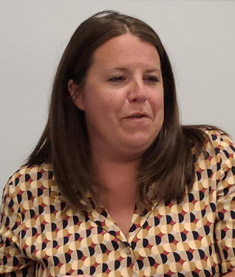
- Registered charity working at the intersection of urban agriculture and climate action.
- Project work includes empowering people to grow their own food, advocating for more urban agriculture, and supporting local food security.
- Programs include their My Fed Farm program – it ran for four years where food growing kits were delivered out into community – planters, soil seeds and educ materials. Started during the pandemic. To date have delivered over 4,016 planters or about 8,000 sq ft of growing capacity which could translate to over 20,000 lb of food per year.
- They have worked with 32 community partners including municipalities, other non-profits and First Nations.
- The free food program met with some challenges, such as people wondering if they could grow food at a rental property or on a balcony; a cross-municipal bylaw about this would alleviate this decision-making from landlords.
- Materials for growing food were delivered to 514 homes in 2020. Challenges for continued success include direct to household delivery capacity and providing enough skill-building support, as well as households having to invest further (seeds, soil, etc) in subsequent years.
- Princess Anne toured the FED Urban farm in April 2024. The farm is located in Dockside Green where the soil base is brownfield contaminated, so all food is grown in modular planters where soil health management can be given full attention.
- The City of Victoria has been a leader in supporting household food growing, including community gardens and boulevards. They have a food systems coordinator on staff.
- Food growing spaces don’t have to be permanent, but can be productive on land that is yet to be developed. Rooftops, vacant parking lots, and brownfields offer opportunities for skillful food-growing. The CRD has a lot of land that is not being used.
- Tax breaks for land developers or density bonuses could help see food production integrated into developments.
- [Brianna Stewart’s full presentation is in the Urban Food Panel Report – July 24, 2024 – available by donation from Urban Food Resilience Initiatives Society]
NATHAN TENNEY – Cafe operator at VOSINO Cafe, who overhauled his entire urban backyard into a food-growing garden.

- Nathan Tenney has developed his small one-tenth-of-an-acre urban back yard into a food-growing space. Previously the yard was all lawn. First the 50 ft x 25 area was fenced against intrusion by deer.
- His interest in hospitality, restaurants and food has driven his interest in growing food. He follows a permaculture perspective including sustainability and diversity of plant types and companion-planting of plants that support each other’s growth, as well as supporting local wildlife like local native pollinator plants.
- He takes a no-dig approach — no tilling, but rather mulching and layering to amend soil health.
- Gardening can be labour-intensive. Take approaches that are realistic for the local growing conditions.
- Two 18″ raised beds and a pathway were the first year’s project. Now the rest of the yard is layered; the lawn was covered with large pieces of cardboard, and soil was layered on top, as well as leaves. By springtime a single layer of soil was available for planting. The previous sod decomposed into the soil. The cardboard disintegrated due to rain over the winter.
- By comparison, landscape fabric is made from plastic.
- Added soil cost him about $500 when layering. Wood for creating the contained garden beds was expensive. He bought a small 6×6 ft greenhouse online for about $400 where he grows all his starter plants. He sources seeds locally from farmers and seed events.
- Irrigation by the drip method with a timer will reduce time for watering. Do a little bit of weeding every day, to keep that aspect under control.
- A medical and herb garden wraps around the house.
- [Nathan Tenney’s full presentation is in the Urban Food Panel Report – July 24, 2024 – available by donation from Urban Food Resilience Initiatives Society]
STEVE UNGER – Lead, Microgrid Development, with SHIFT Energy Group:

- It takes a lot of energy to grow, process and store food.
- Hotter, drier summers present a challenge for BC Hydro to produce enough hydroelectricity.
- Demand for electricity is increasing rapidly. Electric vehicles, heat pumps, and electrification of many aspects of our lives is happening for good reason… there is less fossil fuel usage.
- BC Hydro is now seeking power from other sources, including wind and solar.
- Solar is abundant in the summer and it’s appropriate for BC Hydro to hold their water back in their reservoirs.
- Solar energy produced locally on homes and urban buildings doesn’t go back into the grid, it flows to neighbours (microgrid). Reduces the possibility of brownouts.
- Storage of fresh and frozen food using local power sources is important, as well as for plugging in and recharging appliances and phones. Solar-generated energy with battery backup is clean energy.
- For houses with their own solar energy setup, the electricity is cheaper (about 9 cents/Kwh for about 25 years) compared to purchasing it from BC Hydro (on average about 14 cents/Kwh now, but with annual increases).
- Federal government introduced an investment tax credit for solar installations. Solar is a quickly depreceable asset for tax purposes. The federal and BC governments have a heat pump grant program. BC Hydro offers rebates for solar installation and battery installation. There is the federal Greener at Home Grant program.
- Buildings can now be more energy efficient (BC Energy Step Code).
- Now builders can make homes solar-ready.
- Municipalities could be required to install solar panels at every outdoor parking lot.
- Emergency Centers for community support in disasters require electrical supply with battery backup.
- [Steve Unger’s full presentation is in the Urban Food Panel Report – July 24, 2024 – available by donation from Urban Food Resilience Initiatives Society]
What UFRIS does:
Growing natural food in urban spaces is what Urban Food Resilience Initiatives Society (UFRIS) is all about.
There is a strong and vibrant food-grower community out there already. What UFRIS does is advocate for urban buildings and infrastructure that supports people growing a bit of food backup supply at home as well as communities growing and storing food for emergency backup.
UFRIS is about advocating for food-growing capacity in all built-structures: natural food in urban spaces. That includes houses, townhomes and condos, office buildings, schools and more. The food-growing space could be in household yards, on balconies and patios, in community gardens in a strata space, or indoors with vertical farming technology.
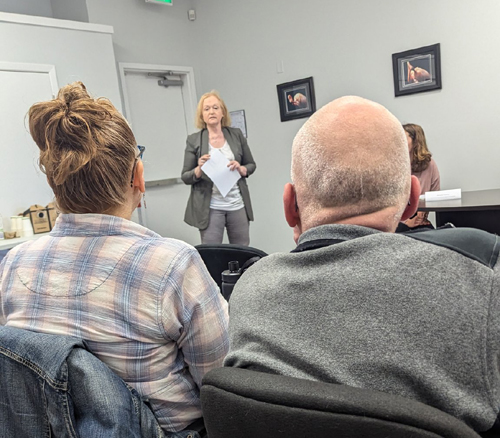
The UFRIS group is connecting with municipalities about the development permit process (every permit should now include a food-growing requirement) and is exploring the setup of frozen food storage capacity within neighbourhoods and communities.
UFRIS is connecting with residents to learn what they’re growing and to provide information on food-growing success within the urban built environment.
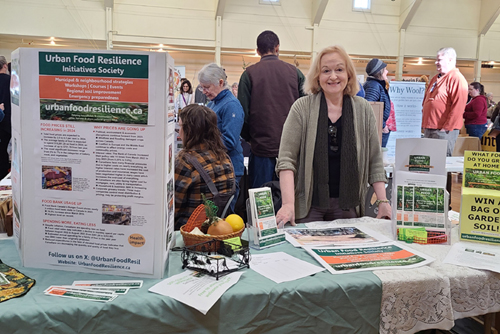
The non-profit group with a regional mission got started in January this year thanks to some insightful grant support from the City of Langford. UFRIS has been growing along with the spring and summer seasons to expand their activity in the food-growing and emergency preparedness communities.
The start of something big:
“Today is the beginning of something very big,” said Mary Brooke at the July 24 event. “This is our first intensive study of how to move forward with growing natural food in urban spaces.”
UFRIS has done some information booths but the Urban Food Panel was getting deeper into the nitty-gritty of how to work with municipalities, use of solar energy, and soil management so people can successfully grow their food.

“In our south Vancouver Island climate people can grow food a little more successfully than in other places in Canada,” said Brooke.
She explained: “That’s a super plus! From a nutrition point of view there are many micro-nutrients, but basically people will be able to get their B-complex vitamins, A and C, and iron, from what what they can grow in their back yards. That would be primarily from leafy greens, squash and zucchini, and Brassicas like broccoli, kale, cauliflower, and Brussels sprouts that are relatively easy to grow for a first-year gardener,” said Brooke who started the UFRIS group in January of this year.
Health Canada in their Canada Food Guide recommends that people eat seven to 10 types of fruits and vegetables every day. “A lot of people aren’t doing that because of costs now,” says Brooke.
That dietary recommendation standard started with cancer research years ago where a range of fresh fruits and vegetables daily was recommended.
Growing at home does take some setup and skill-building. A big part of what UFRIS will be doing, a lot of workshops and some courses. We’ll be offering education that is fun and informative.
In days gone by in cities, most people had a backyard. Now people live in townhomes, condos and apartments. People who do have yards can do what Nathan has done and dig up the whole thing and grow food. People with townhomes might have smaller yards. Learning about companion planting and garden organization, harvesting timelines, and placement of bee-pollinating flowers is helpful for home garden success.
Apartments and condos – involves municipalities – requiring every development permit to provide food-growing capacity. Once this ball gets rolling, for municipalities and their planners it will just be a standard thing like discussing the parking. Already having garden box infrastructure on balconies and balconies, and having a proper setup so that balconies above are not leaking water onto balconies below, and can balconies support the weight and function of food-growing. These are building-code type of things. Meetings will be required to move these ideas forward with the various municipal councils to get these sorts of structural things in place.
Office buildings could have indoor vertical food-growing spaces. Planning for those kinds of spaces and that functionality starts with the building design and the motivation of the developer. Rec centres could have food storage on their footprint, with solar panels and generators to maintain electrical supply. Some schools already have garden-plot areas and some indoor growing rooms, but it’s not across the board yet. Large storage warehouses where people store their downsizing things have large rooftops where food-growing could be done.
Emergency freezer storage for food could also be done in standalone kiosk-style buildings (similar to the small BC Hydro nodes that are fronted as houses in suburban neighbourhoods), or in small buildings for other everyday purposes (e.g. community centre) where the freezer capacity is behind the day-to-day operational space.
Food would have to be rotated for freshness every couple of years. That will require an organizational component of leadership and volunteers.
This is all about planning for when food delivery supply does become unavailable. That would include ‘the big one’ (earthquake of 9.0 Magnitude or greater that is expected on Vancouver Island) and the next pandemic — these are times when the grocery store and food bank systems (which are very well established) will be down for a period of time. When roads are caved in and electricity is down, people are going to have to go for some period of time relying on the food that they have. This is where our emergency storage ideas come in.
Many of the participants at the panel event already grow some food either in their yard or in containers or on balconies.
What do you think your municipality is doing to promote food-growing at home? What sort of workshops or training might be needed or wanted in your community to take the next step? What might you want to change in your own food-growing at home or workplace?

===== RELATED:
- New BC Hydro substation coming to Langford (July 5, 2024)
- Emergency food storage for local emergency response (June 18, 2024)
- Urban Food Resilience group pitches new approaches for Langford (February 27, 2024)
- West shore community leaders take on urban food resilience (February 10, 2024)
- Urban food resilience requires municipal leadership (October 29, 2023)
- Urban food resilience directions in Langford (June 9, 2023)



